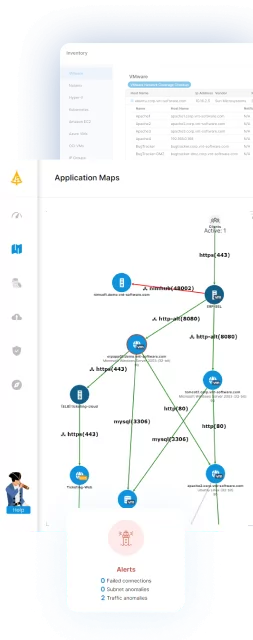What Is Cloud Security?
Cloud security refers to the collection of technologies, policies, controls, and procedures to protect cloud-based systems, data, and infrastructure. As organizations increasingly store critical data and run applications in public, private, or hybrid cloud environments, new security risks emerge. These risks differ from traditional on-premises threats, demanding strategies to control access, protect sensitive information, and detect potential breaches.
Cloud security best practices involve a combination of technical and operational measures to protect data and infrastructure in cloud environments. Key areas include data encryption, access management, network security, and continuous monitoring. Organizations should also focus on incident response planning, security training, and compliance with relevant regulations.
Table of Contents
ToggleCloud security functions across multiple layers, focusing not only on preventing unauthorized access but also on enforcing compliance with regulatory standards. Key concerns include data breaches, misconfigurations, insecure APIs, and account hijacking.
To address these, organizations adopt best practices that emphasize identity management, encryption, data classification, and real-time monitoring to reduce the likelihood and potential impact of security incidents.
10 Best Practices for Strengthening Cloud Security
1. Enforce Least Privilege and Role-Based Access
Enforcing the principle of least privilege ensures that users and systems only have access to the resources necessary for their roles. By limiting access, the potential attack surface is reduced, making it more difficult for malicious actors to gain access to sensitive information. This practice minimizes the risk of human error or compromised accounts leading to larger security breaches.
Role-based access controls (RBAC) further refine this by organizing users into roles with predefined permissions, which simplifies security management while ensuring that only authorized personnel can interact with resources.
RBAC also helps in compliance efforts by ensuring that access control policies are consistently applied. By managing user privileges based on roles, organizations can more easily demonstrate adherence to regulatory requirements, such as GDPR or HIPAA, which often require strict access controls.
2. Encrypt Data at Rest and in Transit
Encryption is one of the fundamental strategies to protect cloud data from unauthorized access. Data at rest, which refers to inactive data stored in cloud environments, must be encrypted to prevent exposure in the event of a data breach. Cloud providers often offer built-in encryption capabilities, but organizations should ensure that encryption keys are managed securely and are separate from the data to improve security further.
Implementing strong encryption algorithms, such as AES-256, can provide protection for data stored in the cloud. In addition to protecting data at rest, organizations must also focus on securing data in transit. As data moves between users, applications, and cloud services, it is vulnerable to interception or tampering.
Using secure transmission protocols like TLS (Transport Layer Security) ensures that data is encrypted during transit, maintaining its confidentiality and integrity. Organizations should require encryption for all data moving across the cloud network, including API communications and remote access points.
3. Classify and Label Sensitive Data
Data classification is a critical step in identifying and protecting sensitive information within cloud environments. By categorizing data based on its level of sensitivity—such as public, internal, or highly confidential—organizations can apply appropriate security measures based on the risks associated with each category.
This helps in preventing overprotecting less critical data while ensuring the highest level of security is applied to the most sensitive information. Classifying data also aids in compliance with data privacy regulations, which often require organizations to implement safeguards for sensitive data types.
Labeling sensitive data ensures that both automated systems and users can quickly identify high-risk information and apply the necessary security measures. By tagging data with appropriate labels, organizations can enforce encryption, access controls, and data retention policies effectively. This also enables the monitoring and auditing process, as labeled data is easier to track for compliance and security auditing purposes.
4. Implement Data Loss Prevention (DLP) Policies
Data loss prevention (DLP) policies detect and prevent unauthorized access, sharing, or transfer of sensitive data across cloud environments. DLP tools typically monitor and enforce policies regarding what data can be shared, by whom, and through which channels, such as email, cloud storage, or APIs.
These tools can automatically flag or block any attempt to move sensitive data outside the organization’s security perimeter, ensuring that confidential information remains protected from accidental or malicious exposure. A well-implemented DLP strategy can help reduce the risk of insider threats and data breaches caused by human error or negligence.
It can also be an essential part of an organization’s compliance framework, especially in regulated industries where strict controls over data handling and sharing are mandatory. Organizations should regularly assess their DLP policies and refine them to adapt to new threats, such as emerging data-sharing technologies or cloud-based collaboration tools.
5. Configure Firewalls and Security Groups
Firewalls are a fundamental element of cloud security, acting as the first line of defense between internal systems and external threats. By properly configuring firewalls, organizations can filter incoming and outgoing traffic based on predefined rules, blocking unauthorized access to cloud infrastructure.
Cloud-based firewalls offer flexibility, scalability, and the ability to integrate with other security services, such as intrusion detection and prevention systems (IDPS). These firewalls should be configured to permit only trusted traffic. Security groups function as virtual firewalls at the instance or virtual machine level.
By grouping resources together and applying security policies that define which inbound and outbound traffic is allowed, organizations can further tighten their security. Configuring security groups with strict access controls ensures that each resource only communicates with authorized peers.
Related content: Read our guide to cloud security architecture (coming soon)

Lanir specializes in founding new tech companies for Enterprise Software: Assemble and nurture a great team, Early stage funding to growth late stage, One design partner to hundreds of enterprise customers, MVP to Enterprise grade product, Low level kernel engineering to AI/ML and BigData, One advisory board to a long list of shareholders and board members of the worlds largest VCs
Tips from the Expert
In my experience, here are tips that can help you better secure cloud environments beyond the common best practices:
- Isolate management interfaces from public networks: Ensure that cloud console access, management APIs, and administrative services are placed behind private or bastion networks. Exposing them to the internet, even with MFA, increases risk.
- Deploy ephemeral cloud resources with auto-expiry: Use automation to assign expiration times to temporary cloud resources (e.g., test VMs, ephemeral keys). This reduces the attack surface by cleaning up unused resources that often get forgotten.
- Use canary tokens in cloud storage: Plant fake credentials, config files, or documents in cloud buckets and monitor for any access attempts. These decoys provide high-fidelity alerts when attackers are poking around.
- Separate encryption key management from cloud provider: Use an external key management system (KMS) or hardware security module (HSM) for sensitive workloads. This prevents dependency on cloud-native encryption keys being misused or subpoenaed.
- Control shadow IT with sanctioned SaaS registry: Track and approve cloud applications used across departments. Use a cloud access security broker (CASB) to discover unsanctioned tools and redirect users to secure alternatives.
6. Set Up Real-Time Alerts
Real-time alerts are crucial for identifying and responding to potential security incidents as they occur. By setting up monitoring tools to track network activity, user behaviors, and system configurations, organizations can detect anomalies that may signal an attempted breach or malicious activity.
For example, abnormal login patterns, failed access attempts, or large data transfers may indicate a security risk that requires immediate investigation. By receiving alerts in real time, security teams can quickly respond and mitigate potential threats before they escalate.
Effective alert systems should be customizable, allowing organizations to prioritize the severity of different types of incidents and filter out false positives. Implementing an incident response protocol, alongside real-time alerting, ensures that alerts are acted upon swiftly and correctly. Integrating alerting systems with automated remediation tools can help reduce response times.
7. Maintain an Inventory of Assets
Maintaining an up-to-date inventory of all cloud assets is essential for managing security in the cloud. This includes tracking virtual machines, storage volumes, networking components, and any other resources deployed in the cloud environment.
An accurate asset inventory helps organizations identify vulnerabilities, misconfigurations, and unauthorized resources that could pose a security risk. Regularly auditing this inventory ensures that organizations are aware of all active assets, making it easier to monitor for potential threats or compliance violations.
Having an inventory also enables organizations to manage resources more efficiently and allocate security controls based on the criticality of each asset. For example, high-value or high-risk assets may require more stringent security measures, such as multi-factor authentication (MFA) or specialized encryption.
8. Implement Backup and Disaster Recovery Solutions
Cloud environments are vulnerable to a range of disruptions, from cyberattacks to hardware failures, making backup and disaster recovery strategies crucial for ensuring business continuity. Implementing a backup strategy ensures that critical data can be restored if lost, corrupted, or compromised.
Regular backups should be conducted for all essential systems and data, with copies stored in geographically dispersed locations to protect against natural disasters or regional outages. Cloud-based backup solutions offer scalability, flexibility, and automation to simplify this process.
Disaster recovery plans (DRPs) should be tailored to the needs of the organization, identifying critical systems and the recovery point objectives (RPOs) and recovery time objectives (RTOs) required to minimize business disruption. These plans should include a clear, documented process for restoring data and systems in the event of a disaster.
9. Monitor and Audit Cloud Resources Continuously
Continuous monitoring and auditing are essential for maintaining a strong cloud security posture. By constantly reviewing system logs, access events, and user activities, organizations can detect potential threats, identify vulnerabilities, and enforce compliance with security policies.
Tools that automate log collection and analysis can provide real-time insights into cloud environments, highlighting suspicious activities or misconfigurations that could expose the organization to risk.
Regular auditing of cloud resources is also necessary for identifying any deviations from security best practices or compliance requirements. Automated audit tools can help ensure that security controls are consistently applied, and that any gaps are quickly addressed. Continuous monitoring and auditing improve security and provide documentation for regulatory compliance.
10. Conduct Security Awareness Programs
Human error remains a common cause of security breaches in cloud environments. Security awareness programs are essential for educating employees about cloud security risks and best practices. These programs should cover topics such as identifying phishing attempts, safe password management, and recognizing suspicious activities in cloud applications.
Regular training sessions and simulations can help employees stay informed and vigilant, reducing the likelihood of mistakes that could lead to security incidents. In addition to training, fostering a culture of security within the organization is critical. Employees should feel empowered to report potential security issues without fear of repercussions.
Organizations can also incorporate security awareness metrics to evaluate the effectiveness of their training programs, identifying areas that need improvement. By continuously reinforcing the importance of cloud security, companies can create a more resilient workforce that contributes to the protection of cloud-based assets.
Enhancing Cloud Security with Faddom Dependency Mapping
As organizations adopt these best practices, maintaining visibility and control across complex hybrid environments becomes increasingly challenging. Faddom offers agentless, real-time application dependency mapping that supports many cloud security measures mentioned above. With Faddom, IT teams can:
- Maintain a real-time inventory of assets across both cloud and on-premises environments to support monitoring, auditing, and compliance.
- Detect unexpected east-west traffic and unauthorized communication paths between systems, reducing exposure to internal threats.
- Visualize application dependencies to understand the impact of changes, support data loss prevention (DLP) policies, and prevent misconfigurations.
- Identify shadow IT and unsanctioned services through comprehensive traffic analysis.
- Plan segmentation and isolation strategies by mapping subnet-level dependencies without disrupting operations.
With deployment taking less than 60 minutes, Faddom enables continuous visibility without needing agents or credentials. It is a lightweight, scalable solution for organizations aiming to secure their infrastructure while reducing complexity.




